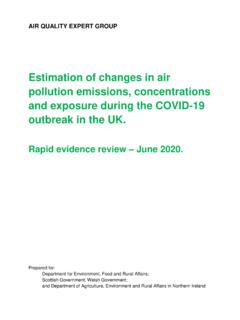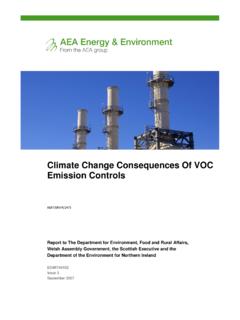Transcription of Air Pollution from Agriculture
1 AIR QUALITY EXPERT GROUP Air Pollution from Agriculture Prepared for: Department for Environment, Food and Rural Affairs; Scottish Government; Welsh Government; and Department of the Environment in Northern Ireland AIR QUALITY EXPERT GROUP Air Pollution from Agriculture Prepared for: Department for Environment, Food and Rural Affairs; Scottish Government; Welsh Government; and Department of the Environment in Northern Ireland This is a report from the Air Quality Expert Group to the Department for Environment, Food and Rural Affairs; Scottish Government; Welsh Government; and Department of the Environment in Northern Ireland, on air Pollution from Agriculture . The information contained within this report represents a review of the understanding and evidence available at the time of writing.
2 Crown copyright 2018 Front cover image credit: Defra United Kingdom air quality information received from the automatic monitoring sites and forecasts may be accessed via the following media: Freephone Air Pollution Information Service 0800556677 Internet PB14509i Terms of Reference The Air Quality Expert Group (AQEG) is an expert committee of the Department for Environment, Food and Rural Affairs (Defra) and considers current knowledge on air Pollution and provides advice on such things as the levels, sources and characteristics of air pollutants in the UK. AQEG reports to Defra s Chief Scientific Adviser, Defra Ministers, Scottish Ministers, the Welsh Government and the Department of the Environment in Northern Ireland (the Government and devolved administrations). Members of the Group are drawn from those with a proven track record in the fields of air Pollution research and practice.
3 AQEG s functions are to: Provide advice to, and work collaboratively with, officials and key office holders in Defra and the devolved administrations, other delivery partners and public bodies, and EU and international technical expert groups; Report to Defra s Chief Scientific Adviser (CSA): Chairs of expert committees will meet annually with the CSA, and will provide an annual summary of the work of the Committee to the Science Advisory Council (SAC) for Defra s Annual Report. In exception, matters can be escalated to Ministers; Support the CSA as appropriate during emergencies; Contribute to developing the air quality evidence base by analysing, interpreting and synthesising evidence; Provide judgements on the quality and relevance of the evidence base; Suggest priority areas for future work, and advise on Defra s implementation of the air quality evidence plan (or equivalent); Give advice on current and future levels, trends, sources and characteristics of air pollutants in the UK; Provide independent advice and operate in line with the Government s Principles for Scientific Advice and the Code of Practice for Scientific Advisory Committees (CoPSAC).
4 Expert Committee Members are independent appointments made through open competition, in line with the Office of the Commissioner for Public Appointments (OCPA) guidelines on best practice for making public appointments. Members are expected to act in accord with the principles of public life. Further information on AQEG can be found on the Group s website at: ii Membership Chair Professor Paul Monks University of Leicester Members Dr James Allan National Centre for atmospheric Science, University of Manchester Dr David Carruthers Cambridge Environmental Research Consultants Dr David Carslaw Ricardo Energy and Environment and University of York Dr Gary Fuller King's College London Professor Roy Harrison OBE University of Birmingham Dr Mat Heal University of Edinburgh Professor Alastair Lewis National Centre for atmospheric Science.
5 University of York Dr Eiko Nemitz Centre for Ecology & Hydrology Professor Claire Reeves University of East Anglia Professor Martin Williams King's College London iii Ad hoc members Professor David Fowler CBE Formerly Centre for Ecology and Hydrology Dr Ben Marner Air Quality Consultants Dr Andrew Williams University of Chester Ex officio members Central Management and Control Unit of the automatic urban and rural networks: Dr Richard Maggs, Bureau Veritas National atmospheric Emissions Inventory: Dr Tim Murrells, Ricardo Energy and Environment Non-automatic hydrocarbon monitoring networks and metals monitoring network: Dr Paul Quincey, National Physical Laboratory Quality Assurance and Quality Control of the automatic urban network and the non-automatic monitoring networks: Dr Paul Willis, Ricardo Energy and Environment Assessors and observers Simon Baldwin Welsh Government Barry McCauley Department of the Environment in Northern Ireland Andrew Taylor Scottish Government Alison Gowers Public Health England Secretariat Dr Sarah Moller National Centre for atmospheric Science, University of York and Department for Environment, Food and Rural Affairs iv Dr Ailsa Stroud Department for Environment, Food and Rural Affairs Michelle Brailey-Balster Department for Environment, Food and Rural Affairs v Acknowledgements The Air Quality Expert Group would like to acknowledge the following individual and organisation for their help in the preparation of this report: Professor Mark Sutton Centre for Ecology and Hydrology Prepared for.
6 Department for Environment, Food and Rural Affairs; Scottish Government; Welsh Government; and Department of the Environment in Northern Ireland vi Contents Q1. What pollutants are emitted by Agriculture ? .. 9 Q2. What are the impacts of ammonia upon human health and the environment? .. 9 Q3. How can these impacts best be addressed / targeted? .. 9 Q4: How have concentrations and the deposition of NH3 and NH4+ in the UK changed following changes in emissions.. 9 Q 5: How effective have controls on NH3 elsewhere in Europe been in reducing emissions and concentrations of NH3 and particulate matter? .. 10 Q6. Have changes in UK emissions of NOx and NH3 reduced the exceedances of critical loads for nutrient nitrogen? (and are both the oxidised and reduced forms of N equally important for eutrophication?)
7 10 Q7. What are the relative air quality benefits and costs for controls on ammonia emissions? .. 11 2 State of the Evidence .. 12 Q1. What pollutants are emitted from agricultural activities? .. 12 Other gaseous emissions from Agriculture .. 15 Q2. What are the impacts of ammonia upon human health and the environment? 16 Q3. How can these impacts best be addressed / targeted? .. 17 Pollution Swapping .. 20 Mitigating emissions using shelter belts .. 20 Q4: How have concentrations and the deposition of NH3 and NH4+ in the UK changed following changes in emissions.. 21 Reduced nitrogen in gas, liquid and particulate phases .. 22 Ammonia in the gas 22 Particulate NH4+ concentrations in the air .. 23 NH4+ in rain .. 25 27 Q 5: How effective have controls on NH3 elsewhere in Europe been in reducing emissions and concentrations of NH3 and particulate matter?
8 31 Q6. Have changes in UK emissions of NOx and NH3 reduced the exceedances of critical loads for nutrient nitrogen? (and are both the oxidised and reduced forms of N equally important for eutrophication?).. 35 Q7. What are the relative air quality benefits and costs for controls on ammonia emissions? .. 38 Benefits .. 38 Costs .. 40 vii 3 References .. 42 8 Executive Summary This report addresses the research and policy aspects of air pollutants from Agriculture . The approach is to identify the pollutants emitted by Agriculture and the environmental issues to which they contribute in the UK and elsewhere, the extent of knowledge and uncertainty of the sources, fate and effects of the pollutants and available options for control. The main focus is on ammonia, a pollutant largely from agricultural activity and an important contributor to air quality issues in the UK.
9 The report refers to the wider European and global environmental issues to which nitrogen compounds contribute in recent assessments without repeating the detail they contain (European Nitrogen Assessment (Sutton et al 2011), The Global Nitrogen cycle in the 21st century (Fowler et al 2013)). The format of the report is structured around a series of policy questions. It begins with a summary of the key points of the answers to these questions. 9 Q1. What pollutants are emitted by Agriculture ? A: Nitrogen-containing compounds (NO2, NO, NH3, N2O) are emitted to the atmosphere from agricultural activities. In the case of ammonia (NH3) and nitrous oxide (N2O), agricultural sources are the main contributors, comprising 88% and 68% respectively of annual UK emissions in 2016. In addition, agricultural soils are becoming a significant source of nitric oxide (NO) (projected to be 6% of UK NOx emissions by 2030) as emissions from combustion sources are reduced by control measures.
10 Methane and non-methane volatile organic compounds (VOC) are emitted by Agriculture , and livestock are an important source of methane in the UK budget (51% in 2016). The pesticides/fungicides hexachlorobenzene, hexachlorcyclohexane and pentachlorophenol, which are listed in the Stockholm Convention on Persistent Organic Pollutants, are also emitted from agricultural and forestry use. Q2. What are the impacts of ammonia upon human health and the environment? A: The main impacts of ammonia arise through its contribution to (1) formation of particulate matter (PM) and the consequent effects on human mortality and morbidity throughout the UK, and (2) the eutrophication of the semi-natural landscape of the UK leading to marked reductions in plant biodiversity. Ammonium in particle form (NH4+) is a transboundary pollutant , exchanged between European countries.










